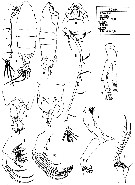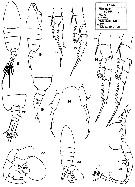|
|
 |
Fiche d'espèce de Copépode |
|
|
Calanoida ( Ordre ) |
|
|
|
Diaptomoidea ( Superfamille ) |
|
|
|
Tortanidae ( Famille ) |
|
|
|
Tortanus ( Genre ) |
|
|
|
Atortus ( Sous-Genre ) |
|
|
| |
Tortanus (Atortus) giesbrechti Jones & Park, 1968 (F,M) | |
| | | | | | | Ref.: | | | Jones & Park, 1968 (p.243, figs.F,M) |  issued from : E.C. Jones & T.S. Park in Crustaceana, 1968, 12 (3). [p.153, Figs.1-11]. Female (from Pago Pago Harbor, Samoa): 1-2, habitus (dorsal and lateral, respectivrly); 3, forehead (ventral); 4, 4th and 5th thoracic segments and urosome (ventral); 5, idem (lateral left side); 6, A1; 7, A2; 8, Md; 9, Mx1; 10, Mx2; 11, Mxp. Nota: Head and 1st thoracic segment separated, 4th and 5th fused. Forehead containing an internal multilobed eye. Head with a prominent sulcus in the dorsal margin (in lateral view). Rostrum absent. 5th thoracic segment in dorsal view, has 4 posterior lobes: the left one is longest, the median one is rounded, the right lobe is equal in length to the median, and there is a short, acute lobe between the right and median lobes; Urosome 2-segmented (segments 1 to 4 fused and the anal segment fused with the caudal rami; the urosome bore extensive chitinous processes; the urosome bore extensive chitinous processes (it is possible that they are accessory spermatophoric material such as is found in the Pontellidae and Acartiidae); these processes are two large vanes on the right and left of the genital region, lying in sagittal planes; the right vane extends more dorsad than ventrad; the left extends more ventrad than dorsad.; the caudal edge of both vanes reaches to a line that includes about 50 p.cent of the length of the caudal rami but the right is slightly longer; the anterior edges of the vanes fit into notches in the 5th thoracic segment. Caudal rami 3 times as long as wide, nearly symmetrical; the distal portion of the internal margin of each ramus bears a patch of fine hair; each ramus bears 6 setae, the 4th from the outside is about 3 times the length of the others. A1 14-segmented. A2 with endopod longer than the exopod, fused with the basipod, and terminates in two partially fused segments which are not distally lobed, with 6 apical setae; the exopd is separated from the basipod, consists of 3 partially fused segments, and has 4 apical setae. Md with an outer articulated spine on the mandibular blade, separed from the other points by a wide diastema; the remaining grouped armament consists of a short articulated spine; 2 blunt bifid processes; a small tooth; and a sharp spinous process; 5 rows of fine spinules are proximal to these grouped processes. Mx1 consists of 2 endopodal lobes, the proximal one with 13 spines and setae and the distal one with 3 long spines. Mx2 is composed of 5 basipodal lobes and 3 endopodal segments; Mxp has only 2 long spines on the 1st segment (similar to that of other members of the subgenus Atortus Sewell, 1932.
|
 issued from : E.C. Jones & T.S. Park in Crustaceana, 1968, 12 (3). [p.155, Figs.12-23]. Female: 12-16, P1 to P5. Nota: P1 with a small tooth on the external margin of the first basipodal segment. Male: 17-18, habitus (dorsal and lateral, respectively); 19, 4th and 5th thoracic segmnts and urosome (right lateral view); 20, idem (dorsal); 21, right A1; 22, P5 (posterior view); 23, sketch of male showing relative size of male P5. Nota: Cephalothorax simolar to that of the female, except that the 5th thoracic segment is not produced into prominent lobes; the corners of that segment asymmetrical, the left slightly longer than the right. 2nd urosomal segment bears 2 spinous processes on the right side (but only one of them is visible in dorsal view); relative lengths of the urosome 13.0:20.3:14.5:11.6:8.7:31.9 (caudal rami) = 100. Caudal rami partially fused with the anal segment; rami asymmetrical (left slightly longer); each ramus bears coarse hair on the internal and external margins and has 6 setae. Right A1 strongly geniculate; the anterior margin of segment 18 with a pectinate, retroverse process which extends proximad almost the length of segment 17; segment 17 has a peculiar spinous process with a bulbous base (as in T. tropicus); segments 19, 20, and 21 fused and bear a smooth, apectinate process similar in size and shape to that of segment 18; these two processes form the jaws of a grasping organ; segments 13 to 17 slightly swollen. P5 very large and make up about 20 % of the volume of the copepod; the proximal (basipodal) segment of the right foot is swollen laterally and without processes; the 2nd segment is a thick, swollen ovoid on the inner margin of which is a thumb bearing 2 short setae; distal to the thumb is the small 3rd segment, which is clawlike with a single short seta; the curved claw is longer than indicated in fig.22
| | | | | Ref. compl.: | | | Bowman, 1971 b (p.527); Ohtsuka, 1992 a (p.265); Nishida & Cho, 2005 (p.232, Fig.4: chart) | | | | NZ: | 1 | | |
|
Carte de distribution de Tortanus (Atortus) giesbrechti par zones géographiques
|
| | | | Loc: | | | SW Pacif. (Pago Pago Harbor, Samoa Is.) | | | | N: | 1 | | | | Lg.: | | | (646) F: 2,7-2,64; M: 2,37; {F: 2,64-2,70; M: 2,37} | | | | Rem.: | According to Jones & Park (1968, p.157) this species is closely related to T. longipes Brodsky from Poset Bay, in the Sea of Japan.
For Nishida & Cho (2005, p.229) this species belongs in the subgenus Atortus to the ''species complex tropicus''. | | | Dernière mise à jour : 01/02/2015 | |
|
|
 Toute utilisation de ce site pour une publication sera mentionnée avec la référence suivante : Toute utilisation de ce site pour une publication sera mentionnée avec la référence suivante :
Razouls C., Desreumaux N., Kouwenberg J. et de Bovée F., 2005-2025. - Biodiversité des Copépodes planctoniques marins (morphologie, répartition géographique et données biologiques). Sorbonne Université, CNRS. Disponible sur http://copepodes.obs-banyuls.fr [Accédé le 29 octobre 2025] © copyright 2005-2025 Sorbonne Université, CNRS
|
|
 |
 |





